
Hydraulic Design
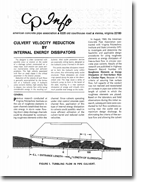 |
Culvert Velocity Reduction By Internal Energy Dissipators Resource # CP-02-702 The designer is often concerned with possible scour or erosion at the outlet of a drainage culvert constructed on a steep slope. High velocities associated with steep slopes are the critical parameter in the erosion process. Reducing the velocity of such flows are accomplished by the formation of hydraulic jumps. This article describes dissipators intended to form hydraulic jumps within culverts. |
 |
Culvert Velocity Reduction With An Outlet Expansion Resource # CP-02-703 This paper describes the concept of using an abrupt expansion at the outlet end of a concrete culvert for the purposes of outlet velocity reduction. The method is intended for culverts operating under conditions of outlet control at maximum discharge. |
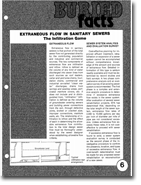 |
Extraneous Flow In Sanitary Sewers – The Infiltration Game Resource # 02-906 Control of extraneous flow in sanitary sewers is a major factor in reducing treatment costs and the amount of inadequately treated sewage discharged to receiving waters. The production of a cost-effective and satisfactorily functioning system can be achieved by utilizing adequate design criteria and assuring the best quality workmanship and materials. |
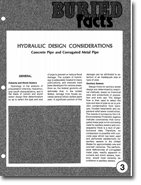 |
Hydraulic Design Considerations – Concrete Pipe and Corrugated Metal Pipe Resource # 02-903 When the various design methods and criteria developed for the different materials available for sewers and culverts are considered, policy decision procedures can become complex. Design methods must be based on theories, modified by model and full-scale testing, and most important, experience. This publication compares the hydraulic performance of smooth-wall concrete pipe versus rough-wall corrugated metal pipe. |
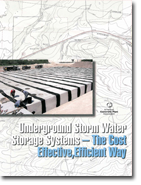 |
Underground Storm Water Storage Systems – The Cost Effective, Efficient Way Resource # 07-129 Keep mainline pipe sizes smaller and/or utilize existing drainage when developing new areas by installing an Underground Storm Water Storage System. In areas prone to heavy rain or flash flooding, this system allows for the collection and storage of the water which can later be discharged into the system at a controlled rate. In dry areas, water can be stored for use during droughts or other times of need. Member price: $25.00 / package of 25 Non-member price: $50.00 / package of 25 Order Now |
 |
The Infrastructure is Collapsing Resource # 07-128 Our infrastructure is deteriorating at an alarming rate. The recent rash of drainage system failures is cause for concern for many reasons, the least of which is major interruption to our public and private thoroughfares. Failure also raises issues of public safety and liability. The public is being hit with costs to repair these deteriorating infrastructures in the manner of taxes and fees. This brochure identifies some recent failures and the known costs of some. Member price: $45.00 / package of 25 Non-member price: $90.00 / package of 25 Order Now |
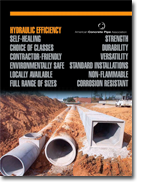 |
Hydraulic Efficiency Resource #07-127 The hydraulic design of a drainage system involves an economic evaluation. Design engineers and owners can select the proper size drainage pipe for a specific culvert or sewer application by applying Manning’s n values as design values and not laboratory values. Member price: $37.50 / package of 25 Non-member price: $75.00 / package of 25 Order Now |
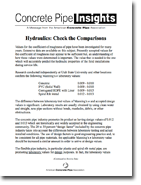 |
Hydraulics: Check the Comparisons Resource # CPI-02 The difference between laboratory test values of Manning’s n and accepted design values is significant. Laboratory results are usually obtained by using clean water and straight, new pipe sections without bends, manholes, debris, or other obstructions. |